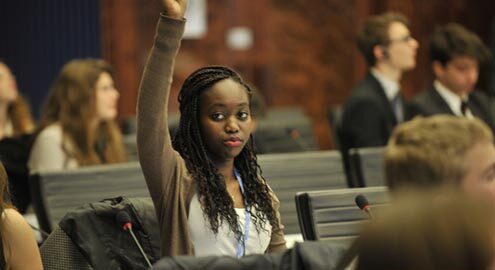Instructions
Overview
When cultivating an open heart, it is essential to understand what tends to get in the way of our capacity to express care for our students and others. To do this, it can be helpful to ask ourselves on an ongoing basis, “When is my heart open in the classroom?” and “When is it closed? And why? What are the triggers?”
This simple inquiry can help us understand more about our own internal state and how this impacts our capacity to feel empathy and compassion and create connections and positive relationships. It can also help us develop greater awareness about our worldview and biases as they relate to our students.
Part A: Focused Listening in Dyads: Overcoming Obstacles to an Open Heart (15-20 minutes)
Participants take turns in pairs listening and speaking on overcoming obstacles to an open heart.
In the next 15-20 minutes you will:
- Introduce the practice, guidelines, and speaking prompt
- Engage in the dyad activity
- Debrief the dyad practice
Focused listening dyad instructions:
- Let the group know that you will be doing a focused speaking and listening activity in pairs. Each partner will have three minutes to speak and three minutes to listen on a particular theme.
- Count the total number of people in the group and divide that number in two. For example, if you have 20 people, count off 1 to 10 and then start again. Each person should then find their matching numbered partner. If there is an odd number of people, then you can participate in a dyad while keeping time, though this is not optimal.
- Tell participants that this listening and speaking practice is structured in a very particular way to give equal and uninterrupted time to each person. This practice is not better or worse than any other kind of communication style, but instead offers a new experience of speaking and listening.
- Share the guidelines for the dyad listed in the section below (aloud and/or on a slide).
- Ask participants to decide which person is ready to speak first. Ask that person to raise their hand so you can see when the group is ready.
- Tell participants that they will have three minutes to speak on the speaking prompt, and that you will ring a chime to let them know when the three minutes are up.
- Give the speaking prompt listed below to the group.
- Ring a bell or chime or give a hand signal for Partner 1 to begin speaking. Partner 2 listens without questions or interruptions.
- When three minutes are up, ring the chime again and tell pairs to switch speakers, so that Partner 2 will now speak on the same prompt. Be sure to tell Partner 2 to NOT respond to what they just heard from Partner 1.
- Partner 1 now listens without questions or interruptions.
- Ring the chime at the end of three minutes to complete the dyad and reconvene the group.
Focused Speaking and Listening Guidelines:
- Each person is given equal time to talk.
- The listener does not speak – to interpret, paraphrase, analyze, give advice, or break in with a personal story.
- Confidentiality is maintained.
- The speaker is not to use the time in the dyad to criticize or complain about the listener or mutual acquaintances.
- Silence is honored: if the speaker finishes with their sharing before the three minutes are up, the pair honors the silence until the end of the time.
- Note: The dyad partners can experiment with eye contact, finding what is most comfortable for each person. (The debrief at the end of the practice can be an opportunity to share that different cultures feel differently about eye contact.)
Speaking prompt:
- What tends to open your heart in the classroom? What tends to close your heart in the classroom?
Briefly debrief the Focused Listening practice:
- Ask for a few people to share a response to each of the following questions (ask the questions one at a time) :
- What was it like to be the listener? (take 3-4 replies)
- What was it like to be the speaker? (take 3-4 replies)
** Note: It is helpful to validate the different experiences people have with this practice. For example, one person may feel very uncomfortable with simply listening/speaking without interruptions for three minutes, while others may feel relieved. Ask people to share different kinds of experiences. For example, if one person shares that it feels unnatural not to comment during someone’s sharing, ask if anyone else had a different experience.
Let them know that this is a practice designed to help us grow our communication skills and to recognize where our growth edges are. Are we more comfortable listening or speaking? What is difficult for us and why? Explain that often in a group, dominant speakers get more air time, even though all group members have important ideas. This equity practice allows each person to have their time and voice valued.
Part B: Dialogue in Groups of Four – Overcoming Obstacles to an Open Heart (10 minutes)
Groups of four take turns sharing ways they open a closed heart.
Group dialogue instructions:
- Ask each dyad pair to find another pair and form a group of four.
- Tell groups that they have five minutes total for each person in the group to share their thoughts with other group members.
- Let groups know that it is important for them to be aware of each person’s airtime and to give every person a chance to speak once before anyone speaks twice.
- Alert the groups when two minutes are left so they can monitor their time.
Speaking prompt for the group:
- Please give some examples and strategies for how you open your heart again once it has closed
Briefly debrief the group dialogue:
- After the five minutes, take a brief comment from a few groups.
Part C: Silent Written Reflection – Overcoming Obstacles to an Open Heart (5 minutes)
Individuals complete a written reflection.
- Tell the group:
- Take the next three minutes to write silently on your notepad.
- Write down the two or three activities that you will try in the next week to Overcome Obstacles to an Open Heart.
Part D: Closure — Distribute handout on Overcoming Obstacles to an Open Heart (3 minutes)
- Thank everyone for their engagement and creativity.
- Distribute the handout at the end of the session for additional support.
- You may wish to follow up in another session with a discussion of this handout and see what people have noticed about themselves since you last met.
Source
This is a practice from PassageWorks Institute courses and workshops. (eg. Creating Engaged Classrooms, and SEL and Equity). You can also read more about this practice in The Five Dimensions of Engaged Teaching: A Practical Guide for Educators by Laura Weaver and Mark Wilding (Solution Tree 2013).








Comments